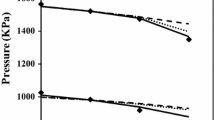Abstract
The changes in Gibbs free energy (ΔG int), enthalpy (ΔH int) and entropy (TΔS int) upon complexation between riboflavin (RF) and N,N-dioctadecyl-[1,3,5]triazine-2,4,6-triamine (DTT), mediated by triple hydrogen bonds at water/carbon tetrachloride, trichloroethylene and chloroform interfaces, were determined via temperature-controlled interfacial tension measurements. It was shown that hydrogen bonding interactions between RF and DTT were best characterized by large and negative ΔH int values, unlike those predicted from either the polarity in each phase or the arithmetic average of the polarities in the two phases. Furthermore, the ΔH int values became more positive as the dielectric constant of the oil phase was increased. These results strongly indicate that ΔH int is governed by the dielectric properties of the oil phase. Adsorption of RF, DTT and the RF-DTT complex at the water/oil interface gave rise to restrictions on the translational and rotational motions of these species, as demonstrated by the ΔS int values observed, which is another characteristic of interfacial complexation. The thermodynamic parameters evaluated in the present study revealed the characteristic complexation behavior that occurs at a water/oil interface, as mediated by hydrogen bonding.









Similar content being viewed by others
References
Ariga K, Kunitake T (1998) Acc Chem Res 31:371–378
Gohlke H, Klebe G (2002) Angew Chem Int Ed 41:2644–2676
Shigemori K, Nishizawa S, Yokobori T, Shioya T, Teramae N (2002) New J Chem 26:1102–1104
Ishizaka S, Kinoshita S, Nishijima Y, Kitamura N (2003) Anal Chem 75:6035–6042
Ishizaka S, Kitamura N (2004) Anal Sci 20:1587–1592
Kurihara K, Ohto K, Honda Y, Kunitake T (1991) J Am Chem Soc 113:5077–5079
Sakurai M, Tamagawa H, Inoue Y, Ariga K, Kunitake T (1997) J Phys Chem B 101:4810–4816
Ishizaka S, Kitamura N (2001) Bull Chem Soc Jpn 74:1983–1998
Ishizaka S, Kim H-B, Kitamura N (2001) Anal Chem 73:2421–2428
Ishizaka S, Habuchi S, Kim H-B, Kitamura N (1999) Anal Chem 71:3382–3389
Ishizaka S, Nakatani K, Habuchi S, Kitamura N (1999) Anal Chem 71:419–426
Adamson W (1990) Physical chemistry of surfaces. Wiley, New York, p 27
Rotenberg Y, Boruvka L, Neumann AW (1983) J Colloid Interf Sci 93:169–183
Kakiuchi T, Nakanishi M, Senda M (1988) Bull Chem Soc Jpn 61:1845–1851
Wilcox CS, Cowart MD (1986) Tetrahedron Lett 27:5563–5566
Jadzyn J, Malecki J (1972) Acta Phys Polon 41:599–616
Aquino AJA, Tunega D, Haberhauser G, Gerzabek MH, Lischka H (2002) J Phys Chem A 106:1862–1871
Yasuda T, Ikawa S (1998) Chem Phys 238:173–178
Tamagawa H, Sakurai M, Inoue Y, Ariga K, Kunitake T (1997) J Phys Chem B 101:4817–4825
Steel WH, Damkaci F, Nolan R, Walker RA (2002) J Am Chem Soc 124:4824–4831
Steel WH, Walker RA (2003) J Am Chem Soc 125:1132–1133
Steel WH, Walker RA (2003) Nature 424:296–299
Adrian JC, Wilcox CS (1991) J Am Chem Soc 113:678–680
Whitesides GM, Mathias JP, Seto CT (1991) Science 254:1312–1319
Rekharsky MV, Inoue Y (1998) Chem Rev 98:1875–1917
Williams DH, Cox JPL, Doig AJ, Gardner M, Gerhard U, Kaye PT, Lal AR, Nicholls IA, Salter CJ, Mitchell RC (1991) J Am Chem Soc 113:7020–7030
Hayashi T, Miyahara T, Koide N, Ogoshi H (1997) Chem Commun 19:1865–1866
Richmond GL (2002) Chem Rev 102:2693–2724
Walker DS, Brown MG, McFearin CL, Richmond GL (2004) J Phys Chem B 108:2111–2114
Acknowledgements
The authors are grateful for a Grant-in-Aid for Scientific Research from the Ministry of Education, Culture, Sports, Science, and Technology of the Japanese Government, which supported the research (No. 15750061 and No. 13129201 (Priority Research Area on “Nano-Chemistry at Liquid-Liquid Interfaces”).
Author information
Authors and Affiliations
Corresponding author
Rights and permissions
About this article
Cite this article
Ishizaka, S., Nishijima, Y. & Kitamura, N. A thermodynamic study on the complexation between riboflavin and a diaminotriazine derivative mediated by triple hydrogen bonds at water/oil interfaces. Anal Bioanal Chem 386, 749–758 (2006). https://doi.org/10.1007/s00216-006-0573-4
Received:
Revised:
Accepted:
Published:
Issue Date:
DOI: https://doi.org/10.1007/s00216-006-0573-4




